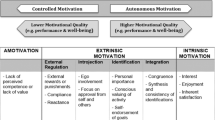Abstract
The purpose of this study was to describe the influence of constructivist classroom contextual factors in a life science laboratory and a traditional science classroom on elementary students’ motivation and learning strategy use. The Constructivist Teaching Inventory was used to examine classroom contextual factors. The Motivated Strategies for Learning Questionnaire was used to examine student motivation and learning strategies. A Wilcoxon nonparametric test determined that constructivist teaching practices were found to occur more often in the life laboratory than in the regular classroom. Although constructivist teaching practices increased at each observation time in both the regular classroom and in the life laboratory, a Friedman test determined that they were not statistically significant increases. Paired sample t tests determined that student motivation and learning strategies were higher in the life laboratory than in the regular classroom overall as well as at each survey time except for learning strategies at Post 1. A 2 × 4 between 3 within repeated measure ANOVA determined that student MSLQ motivation and learning strategy scores in the regular classroom varied statistically significantly by teacher. Student MSLQ motivation and learning strategy scores in the life laboratory varied statistically significantly by teacher. To triangulate data, individual interviews of students were conducted at the end of the semester and revealed students regard the life laboratory as an asset to their science study; however, students do appreciate and value working in the learning environment that the regular classroom provides.
Similar content being viewed by others
References
Alsop, S., Bencze, L., & Pedretti, E. (Eds.). (2005). Analyzing exemplary science teaching. New York, NY: McGraw-Hill Education: Open University Press.
Boekaerts, M. (2002). Bringing about change in the classroom: Strengths and weaknesses of the self-regulated learning approach—EARLI Presidential Address, 2001. Learning and Instruction, 12, 589–604.
Boekaerts, M., Koning, E., & Vedder, P. (2006). Goal-directed behavior and contextual factors in the classroom: An innovative approach to the study of multiple goals. Educational Psychologist, 41(1), 33–51.
Cronk, B. C. (2004). How to use SPSS: A step-by-step guide to analysis and interpretation (3rd ed.). Publisher: Fred Pyrczak.
Duncan, T. G., & McKeachie, W. J. (2005). The making of the motivated strategies for learning questionnaire. Educational Psychologist, 40(2), 117–128.
Dymet, J. E. (2005). Green school grounds as sites for outdoor learning: Barriers and opportunities. International Research in Geographical and Environmental Education, 14(1), 28–45.
Educational Broadcasting Corporation. (2004). Constructivism as a paradigm for teaching and learning. Retrieved January 22, 2008 from http://www.13.org/edonline/concept2class/constructivism/index.html.
Education Insights at Public Agenda. (2006). Reality Check 2006: Are parents and students ready for more math and science? Retrieved January 22, 2008 from http://www.publicagenda.org.
Ertmer, P., & Newby, T. (1993). Behaviorism, cognitivism, constructivism: Comparing critical features from an instructional design perspective. Performance Improvement Quarterly, 6(4), 50–72.
Fraenkel, J. R., & Wallen, N. E. (2003). How to design and evaluate research in education (5th ed.). New York: McGraw-Hill.
Gay, L. R., & Airasian, P. (2000). Educational research: Competencies for analysis and application. New Jersey: Prentice-Hall Inc.
Greer, M. A. (1997). Measuring constructivist teaching practices in first and third grades. Doctoral dissertation, University of Toledo.
Hinkle, D., Wiersma, W., & Jurs, S. (2003). Applied statistics for the behavioral sciences. Boston-NY: Houghton Mifflin Company.
Howard Hughes Medical Institute (HHMI). (2008). Retrieved January 28, 2008 from http://www.hhmi.org/.
Jonassen, D. H., McAleese, T. M. R., & Duffy, T. M. (1993). A manifesto for a constructivist approach to technology in higher education. In T. M. Duffy, J. Lowyck & D. H. Jonassen (Eds.), The design of constructivistic learning environments: Implications for instructional design and the use of technology. Heidelburg, FRG: Springer. Retrieved January 28, 2008 from http://cad017.gcal.ac.uk/clti/papers/TMPaper11.html.
Kadlec, A., Friedman, W., & Ott, A. (2007). Important, but not for me: Parents and students in Kansas and Missouri talk about math, science and technology education. Public Agenda with support from the Ewing Marion Kauffman Foundation.
Krajcik, J., & Czerniak, C. (2007). Teaching science in elementary and middle school: A project-based approach (3rd ed.). New York: Lawrence Erlbaum Associates.
Life Lab Science Program. (2009). Garden based learning that promotes a sustainable future. Retrieved May 21, 2009 from http://www.lifelab.org/index.php?page=about.
Linnenbrink, E. A., & Pintrich, P. R. (2002). Motivation as an enabler for academic success. School Psychology Review, 21(3), 313–327.
National Research Council (NRC). (1996). National science education standards. Washington, DC: National Academy Press.
Noddings, N. (2005). The challenge to care in schools: An alternative approach to education. Advances in contemporary educational thought. Teachers College Press, New York, NY.
Northwest Regional Education Laboratory [NWREL]. (2007). Science inquiry model. Retrieved January 15, 2008 from http://www.nwrel.org/msec/science_inq/answers.html.
Osborne, J., Simon, S., & Collins, S. (2003). Attitudes towards science: A review of the literature and its implications. International Journal of Science Education, 25(9), 1049–1079.
Phillips, J. M., & Gully, S. M. (1997). Role of goal orientation, ability, need for achievement, and locus of control in the self-efficacy and goal-setting process. Journal of Applied Psychology, 82, 792–802.
Pinar, W. F. (2004). What is curriculum theory?. Mahwah, NJ: Lawrence Erlbaum Associates.
Pintrich, P. R. (1999). The role of motivation in promoting and sustaining self-regulated learning. International Journal of Educational Research, 31, 459–470.
Pintrich, P. R. (2000). The role of goal orientation in self-regulated learning. Handbook of self-regulation. San Diego, CA: Academic Press.
Pintrich, P. R., Marx, R. W., & Boyle, R. A. (1993). Beyond cold conceptual change: The role of motivational beliefs and classroom contextual factors in the process of conceptual change. Review of Educational Research, 63, 167–199.
Pintrich, P. R., Smith, D. F., Garcia, T., & McKeachie, W. J. (1991). A Manual for the use of the motivated strategies for learning questionnaire (MSLQ). The Regents of the University of Michigan.
Pugh, K. J., & Girod, M. (2007). Science, art, and experience: Constructing a science pedagogy from Dewey’s Aesthetics. Journal of Science Teacher Education, 18, 9–28.
Raffan, J. (2000). Nature nurtures: Investigating the potential of school grounds. Toronto, ON: Evergreen.
School Gardening Resources. (2009). School gardens. Retrieved May 21, 2009 from http://journeytoforever.org/edu_garden_link.html.
Schunk, D. H. (2005). Self-regulated learning: The educational legacy of Paul R. Pintrich. Educational Psychologist, 40(2), 85–94.
Silva, R. R., Alpert, M., Pouget, E., Silva, V., Trosper, S., Reyes, K., et al. (2005). A rating scale for disruptive behavior disorders, based on the DSM-IV item pool. Psychiatric Quarterly, 76(4), 327–339.
Sorge, C. (2007). What happens? Relationship of age and gender with science attitudes from elementary to middle school. Science Educator, 16(2), 33–37.
Weems, G. H., & Onwuegbuzie, A. J. (2001). The impact of midpoint responses and reverse coding on survey data. Measurement and Evaluation in Counseling and Development, 34(3), 166–176.
Author information
Authors and Affiliations
Corresponding author
About this article
Cite this article
Milner, A.R., Templin, M.A. & Czerniak, C.M. Elementary Science Students’ Motivation and Learning Strategy Use: Constructivist Classroom Contextual Factors in a Life Science Laboratory and a Traditional Classroom. J Sci Teacher Educ 22, 151–170 (2011). https://doi.org/10.1007/s10972-010-9200-5
Published:
Issue Date:
DOI: https://doi.org/10.1007/s10972-010-9200-5




